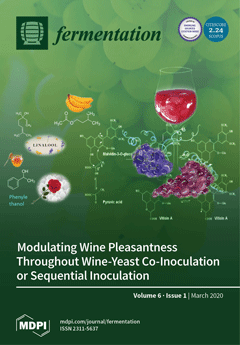A few yeast species have been tested frequently to improve the tastes, flavors, and other important quality parameters of coffee. However, continuing evaluations of different yeast species for fermenting green coffee beans will have a significant positive contribution to the coffee industry. This
[...] Read more.
A few yeast species have been tested frequently to improve the tastes, flavors, and other important quality parameters of coffee. However, continuing evaluations of different yeast species for fermenting green coffee beans will have a significant positive contribution to the coffee industry. This experiment was conducted to evaluate the antioxidant properties, total phenol content (TPC), total flavonoid content (TFC), total tannin content (TTC), and the consumer acceptability of fermented green coffee beans with
Wickerhamomyces anomalu. The coffee beans were roasted at different roasting conditions (light, medium, and dark). There was no significant (
p > 0.05) difference between the yeast-fermented and non-fermented coffee with regard to the oxygen radical absorbance capacity (ORAC) values in medium and dark roasted coffee. Similarly, the superoxide dismutase-like (SOD)-like activity did not significantly differ in all roasting conditions. However, the SOD-like activity was significantly different (
p < 0.05), particularly within light roasted and medium roasted, and between light roasted and dark roasted in both the control and fermented coffee extracts. The 2, 2-diphenyl-1-picrylhydrazyl (DPPH) radical scavenging assay and ferric reducing antioxidant power (FRAP) were improved in fermented coffee beans. There was a significant (
p ≤ 0.05) difference between the yeast-fermented and non-fermented coffee with respect to the TPC and TFC in all roasting types and the TTC in the light and dark roasting conditions. The fermentation of green coffee beans with
W. anomalus increased the TPC and TFC. However, the TTC was lower in the fermented coffee beans compared to the non-fermented coffee beans in medium and dark roasted coffee. In general, fermentation of green coffee beans with
W. anomalus has the potential to improve the functionality of coffee beans.
Full article





